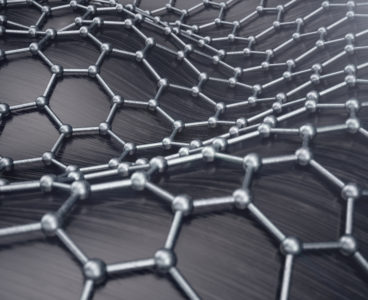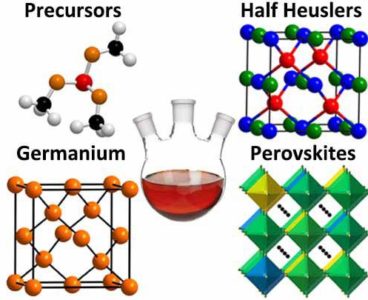Collaborating scientists at the U.S. Department of Energy’s Ames Laboratory, Brookhaven National Laboratory, and Princeton University have discovered a new layered ferromagnetic semiconductor, a rare type of material that holds great promise for next-generation electronic technologies. As the name implies, semiconductors are the Goldilocks of electrically conductive materials—not a metal, and not an insulator, but…
Predicting the Shape of Squeezed Nanocrystals When Blanketed Under Graphene
In a collaboration between the U.S. Department of Energy’s Ames Laboratory and Northeastern University, scientists have developed a model for predicting the shape of metal nanocrystals or “islands” sandwiched between or below two-dimensional (2D) materials such as graphene. The advance moves 2D quantum materials a step closer to applications in electronics. Ames Laboratory scientist are…
Exact Edge between Superconducting and Magnetic States Measured
Materials Contain New Quantum Behaviors
Layered transition metal dichalcogenides or TMDCs—materials composed of metal nanolayers sandwiched between two other layers of chalcogens— have become extremely attractive to the research community due to their ability to exfoliate into 2D single layers. Similar to graphene, they not only retain some of the unique properties of the bulk material, but also demonstrate direct-gap…
Coming Soon to Exascale Computing: Software for Chemistry of Catalysis
The U.S. Department of Energy’s Ames Laboratory is launching a four-year, $3.2 million project to develop software that will bring the power of exascale computers to the computational study and design of catalytic materials. Ames Laboratory scientist Mark Gordon, also the Francis M. Craig Distinguished Professor of Chemistry at Iowa State University, will lead the laboratory’s…
Unique Material Grouping Used for Better Batteries
A first-of-its-kind copper and graphite combination discovered in basic energy research at the U.S. Department of Energy’s Ames Laboratory could have implications for improving the energy efficiency of lithium-ion batteries, which include these components. “We’re pretty excited by this, because we didn’t expect it,” says Pat Thiel, an Ames Laboratory scientist and Distinguished Professor of…
A Pair of Patents Filed on Breakthrough Materials for Next-Gen Refrigerators
Revealing the Mysteries of Superconductors
The U.S. Department of Energy’s Ames Laboratory has successfully demonstrated that a new type of optical magnetometer, the NV magnetoscope, can map a unique feature of superconductive materials that along with zero resistance defines the superconductivity itself. That unique feature is the Meissner effect, which is the expulsion of the magnetic field during a material’s…
Rare Earth Magnet Recycling is a Grind, But New Process Takes a Simpler Approach
Magnetic Fields of Bacterial Cells, Nano-Objects Mapped for First Time
A research team led by a scientist from the U.S. Department of Energy’s Ames Laboratory has demonstrated for the first time that the magnetic fields of bacterial cells and magnetic nano-objects in liquid can be studied at high resolution using electron microscopy. This proof-of-principle capability allows first-hand observation of liquid environment phenomena, and has the…
New Discovery Gets Under Graphite’s Skin
Scientists at the U.S. Department of Energy’s Ames Laboratory have discovered a new process to sheathe metal under a single layer of graphite which may lead to new and better-controlled properties for these types of materials. Graphene — two-dimensional graphite — was first produced in 2004, and because electrons move rapidly along its surface, holds…
Nanoparticle Photoluminescence Gets a Boost from Tin
Researchers at the U.S. Department of Energy’s Ames Laboratory have developed germanium nanoparticles with improved photoluminescence, making them potentially better materials for solar cells and imaging probes. The research team found that by adding tin to the nanoparticle’s germanium core, its lattice structure better matched the lattice structure of the cadmium-sulfide coating, which allows the…
One-Step 3D Printing of Catalysts Developed
The U.S. Department of Energy’s Ames Laboratory has developed a 3D printing process that creates a chemically active catalytic object in a single step, opening the door to more efficient ways to produce catalysts for complex chemical reactions in a wide scope of industries. While 3D printing has found applications in many areas, its use…
Development of Low-dimensional Nanomaterials Could Transform Future Technologies
Javier Vela, scientist at the U.S. Department of Energy’s Ames Laboratory, believes improvements in computer processors, TV displays and solar cells will come from scientific advancements in the synthesis of low-dimensional nanomaterials. Ames Laboratory scientists are known for their expertise in the synthesis and manufacturing of materials of different types, according to Vela, who is…
Dopants Raise Questions about Superconductor Theory
The U.S. Department of Energy’s Ames Laboratory has successfully created the first pure, single-crystal sample of a new iron arsenide superconductor, CaKFe4As4, and studies of this material have called into question some long-standing theoretical models of superconductivity. The material is notable for having the high superconducting temperature of 35K without the need for small amounts…








